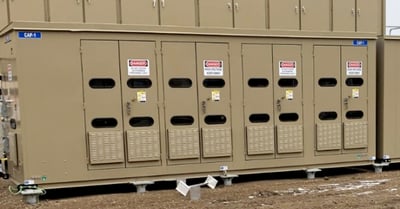 Helical piles are an excellent foundation solution for the oil and gas industry, both in congested and remote areas. They are easy to install and can be uninstalled (if necessary) and reused at another location. They are displacement piles, so they produce no spoils, no time is lost waiting for concrete to cure before loading, and they are installed with minimal environmental impact. For oil and gas applications, helical piles can be the most suitable foundation solution in the segment.
Helical piles are an excellent foundation solution for the oil and gas industry, both in congested and remote areas. They are easy to install and can be uninstalled (if necessary) and reused at another location. They are displacement piles, so they produce no spoils, no time is lost waiting for concrete to cure before loading, and they are installed with minimal environmental impact. For oil and gas applications, helical piles can be the most suitable foundation solution in the segment.
Helical piles offer significant cost savings in material, installation, and transportation.
A single helical pile, with a weight of approximately 250 lbs. can replace up to 100,000 lbs. of dead weight thrust block concrete in a section of the pipeline, which is especially advantageous in remote areas where concrete is not readily available.
Helical piles can be utilized in all three segments of the oil and gas industry: upstream, midstream, and downstream. Here is a selection of applications for helical piles in the oil and gas industry:
- Upstream - exploration and extracting oil and natural gas from the ground
- Production Facilities
- Pumpjacks
- Midstream - storing and transporting them thousands of miles
- Pipelines
- Pumping Stations
- Compressor Stations
- Downstream - converting raw materials into fuels and finished products
- Refineries
- Byproduct Manufacturing Facilities
Midstream is by far the most common application for helical piles. Most of the time, helical piles are used as foundation support for pipelines including retrofit, new construction for above grade and below grade, and buoyancy control. Also, they’re often used for scraper traps, compressor stations, and more.
Because vibration can reduce the life span of the equipment on a compressor station platform, foundations must be installed with minimal vibration, making this an ideal application for helical piles. In addition to vertical piles, battered piles may be considered to support lateral loads, due to wind or seismic activity. Helical piles can be designed and installed to support compression, tension, and lateral loads.
Scrapper traps, also known as launcher, receiver and big traps, are usually located at compressor stations and terminal points of the pipeline. Settling problems are usually associated with concrete slabs under these scrapper traps due to different weather conditions. A helical pile foundation in conjunction with an elevated steel beam, that is bolted to the foundation, is the ideal solution. This system creates an elevated steel platform connection to support the scrapper traps.
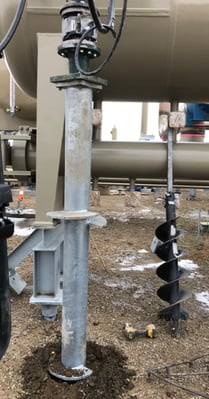 In this picture by Montana Helical Piers, a pipe shaft helical is being installed in a congested area. Thanks to the small installation equipment required, limited access sites are well-suited for helical piles. In this project, the soils were very dense and pre-drilling was required. However, helical piles were still the best option and no spoils were generated.
In this picture by Montana Helical Piers, a pipe shaft helical is being installed in a congested area. Thanks to the small installation equipment required, limited access sites are well-suited for helical piles. In this project, the soils were very dense and pre-drilling was required. However, helical piles were still the best option and no spoils were generated.
Above ground pipeline support is another excellent application for helical piles. They provide complete support to the pipeline, and they connect directly to the steel beam or steel rack as shown. Environmentally sensitive areas are often a concern for traditional concrete piles. The helical piles eliminated the need to dispose of spoils, and they can be installed with readily available equipment using a hydraulic torque motor to screw them down. If corrosion is a concern, helical piles can be galvanized for added protection.
Buoyancy Control Pipeline
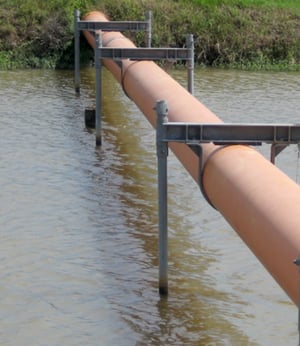 With thousands of miles of oil and gas pipelines across the US and Canada, with many located in remote areas with difficult access and under frozen grounds, helical piles can be an economical option in lieu of the traditional concrete dead weight used to prevent the pipeline from “floating,” or coming out of the ground. Buoyancy control on gas pipelines 20 inches in diameter or larger is necessary especially if you are dealing with organic soils with low shear strength and a high-water table as found in swampy areas. Without buoyancy control, the pipeline will float to the surface when the weight of the pipe plus the backfill is less than the buoyant force on the pipe.
With thousands of miles of oil and gas pipelines across the US and Canada, with many located in remote areas with difficult access and under frozen grounds, helical piles can be an economical option in lieu of the traditional concrete dead weight used to prevent the pipeline from “floating,” or coming out of the ground. Buoyancy control on gas pipelines 20 inches in diameter or larger is necessary especially if you are dealing with organic soils with low shear strength and a high-water table as found in swampy areas. Without buoyancy control, the pipeline will float to the surface when the weight of the pipe plus the backfill is less than the buoyant force on the pipe.
In northern areas where muskeg soil is encountered in the summer and permafrost during the winter, researchers demonstrated the cost benefit of the helical piles. Helical piles can resist uplift forces efficiently, which eliminates the need for heavy trucks loaded with concrete weights to move in and out. This excessive weight and traffic can cause the frozen muskeg to fail, resulting in delays and increased construction costs.
The assembly for a muskeg-permafrost area consists of the helical anchor, anchor termination, and a strap. The helical anchors are installed one on each side of the pipeline, and then attached to the strap which acts as a counteracting force to resist the uplift forces. The anchor holding capacity is developed by the helix plates installed into undisturbed bearing soil. The installation of the anchors is simple and can be done in pairs with the right equipment. One of the helical anchors will be advanced into the ground in the clockwise direction and the other one in the opposite (counterclockwise) direction. For this to happen, right and left-hand pitches are used, which means, one of the anchors will have a left-hand helix and the other a right-hand helix. The design of the helical pile can vary in size and number of helix plates, but it is typically a 1-1/2” square shaft with either a single or double 14” helix . Once it reaches the pre-determined required torque , an anchor termination is installed followed by a steel pipeband or synthetic strap. It’s important to note that the synthetic material on the strap is non-conductive and electrically separate from the other material in the anchoring system. The typical installation for these anchors is for every 65’ (20 m) of the pipeline.
To ensure the pipeline buoyancy control system stability, each anchor can be tension tested to 150% of the working load. Typically, a complete test on one assembly takes about 5 minutes to be completed.
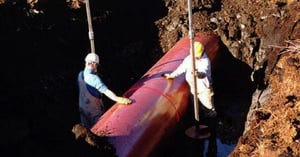
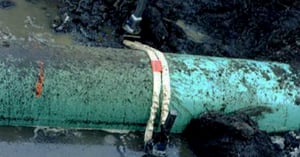
In order to realize the cost savings and full benefits of helical piles, it’s important to have accurate soil data and a precise design. Hubbell Power Systems, Inc. has a team of CHANCE engineers with over 150 years of expertise and the largest helical pile distributor network in North America to give you design assistance and product recommendations. Contact us today!
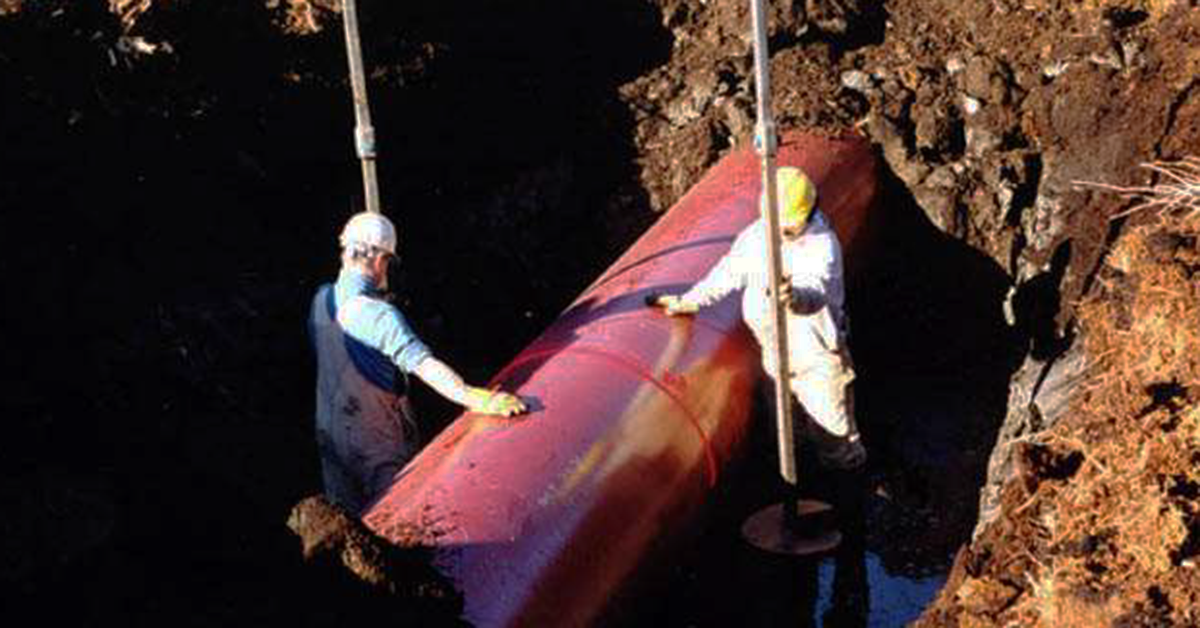
 Helical piles are an excellent foundation solution for the oil and gas industry, both in congested and remote areas. They are easy to install and can be uninstalled (if necessary) and reused at another location. They are displacement piles, so they produce no spoils, no time is lost waiting for concrete to cure before loading, and they are installed with minimal environmental impact. For oil and gas applications, helical piles can be the most suitable foundation solution in the segment.
Helical piles are an excellent foundation solution for the oil and gas industry, both in congested and remote areas. They are easy to install and can be uninstalled (if necessary) and reused at another location. They are displacement piles, so they produce no spoils, no time is lost waiting for concrete to cure before loading, and they are installed with minimal environmental impact. For oil and gas applications, helical piles can be the most suitable foundation solution in the segment. In this picture by
In this picture by  With thousands of miles of oil and gas pipelines across the US and Canada, with many located in remote areas with difficult access and under frozen grounds, helical piles can be an economical option in lieu of the traditional concrete dead weight used to prevent the pipeline from “floating,” or coming out of the ground. Buoyancy control on gas pipelines 20 inches in diameter or larger is necessary especially if you are dealing with organic soils with low shear strength and a high-water table as found in swampy areas. Without buoyancy control, the pipeline will float to the surface when the weight of the pipe plus the backfill is less than the buoyant force on the pipe.
With thousands of miles of oil and gas pipelines across the US and Canada, with many located in remote areas with difficult access and under frozen grounds, helical piles can be an economical option in lieu of the traditional concrete dead weight used to prevent the pipeline from “floating,” or coming out of the ground. Buoyancy control on gas pipelines 20 inches in diameter or larger is necessary especially if you are dealing with organic soils with low shear strength and a high-water table as found in swampy areas. Without buoyancy control, the pipeline will float to the surface when the weight of the pipe plus the backfill is less than the buoyant force on the pipe.



